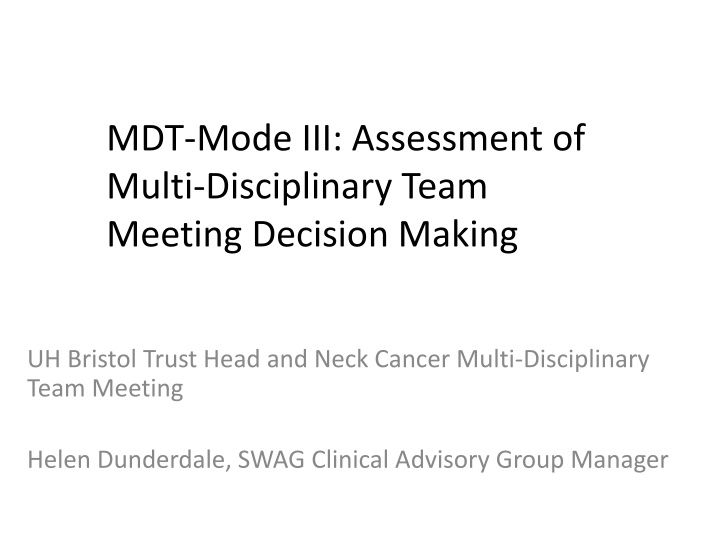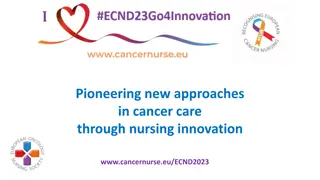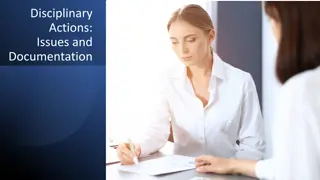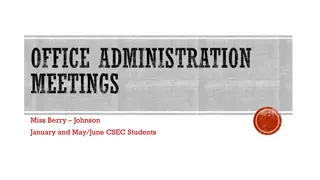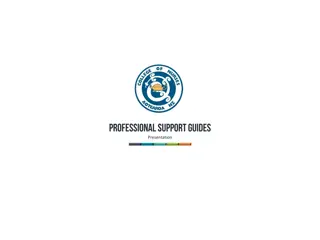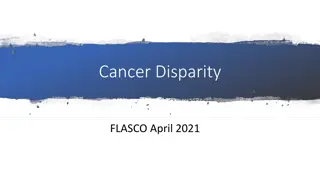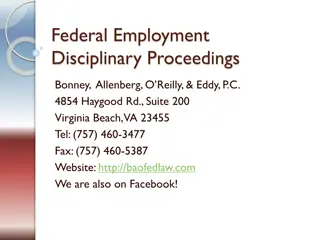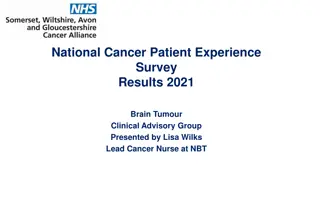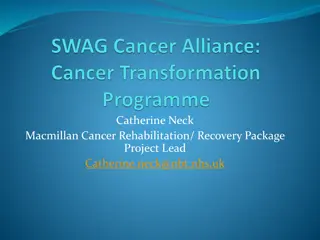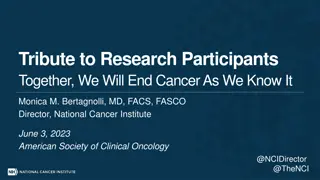Enhancing Multi-Disciplinary Team Meetings in Cancer Care
The article discusses the importance of effective Multi-Disciplinary Team (MDT) meetings in cancer care and the need for reforms to improve decision-making processes and streamline efficiency. It highlights the challenges faced when MDTs do not work effectively together, leading to sub-optimal care and delays in treatment. Various initiatives and reforms, such as incorporating patient-centered information and optimizing MDT meetings, have been undertaken to enhance the quality of care and address long-standing issues identified in MDT capacity and information sharing.
Download Presentation

Please find below an Image/Link to download the presentation.
The content on the website is provided AS IS for your information and personal use only. It may not be sold, licensed, or shared on other websites without obtaining consent from the author.If you encounter any issues during the download, it is possible that the publisher has removed the file from their server.
You are allowed to download the files provided on this website for personal or commercial use, subject to the condition that they are used lawfully. All files are the property of their respective owners.
The content on the website is provided AS IS for your information and personal use only. It may not be sold, licensed, or shared on other websites without obtaining consent from the author.
E N D
Presentation Transcript
MDT-Mode III: Assessment of Multi-Disciplinary Team Meeting Decision Making UH Bristol Trust Head and Neck Cancer Multi-Disciplinary Team Meeting Helen Dunderdale, SWAG Clinical Advisory Group Manager
Background on the purpose Method Results Discussion For the team to collectively agree points for improvements, and how these should be actioned.
Multi-Disciplinary Team Meeting reforms why? It is recognised that Multidisciplinary team (MDT) working is the gold standard in many countries The care of cancer patients has become more complex, with increasing numbers of diagnostic tests, treatments and increased patient empowerment in decision-making When MDTs do not work together effectively care can be sub-optimal; recommendations can be clinically inappropriate, or not acceptable to patients, resulting in delays to treatment, distress for patients and frustration for healthcare professionals Evidence suggests that effective MDT decision-making requires consideration of comprehensive patient-centred information at the point of decision-making. https://www.ncbi.nlm.nih.gov/pmc/articles/PMC5783021/ Purpose: To support the need to streamline and improve the efficiency of MDT meetings due to the increase in workload since their formation.
Regional support to optimise SWAG MDT meetings from the Cancer Clinical Leads: Background: 2014: Site Specific Group Support Service (SSG, now Clinical Advisory Groups, CAGs) commences and MDT reforms added to the Template Agenda and Work Programmes for all CAGs, as advised by the Clinical Leads. 2015: Initial meetings identify long standing cross-cutting issues with MDT capacity / information, with Peer Review measures restricting the potential for change. 2016: CRUK MDT effectiveness review commences with SWAG representatives / MDTs taking part in the process.
Progress 2017: CRUK MDT Effectiveness report published and reviewed by all 12 CAGs potential service improvements identified The late Professor Martin Gore appointed by the National Cancer Board as MDT reform Clinical Lead and initial report reviewed by all 12 CAGs. Contacted by SWAG to express an interest in related projects Peer Review is replaced with Quality Surveillance - MDT meeting attendance rules change CAG Chairs decide to convene the inaugural Meeting of the SWAG Clinical Leads to recommend initiatives for improving Multi-Disciplinary Team (MDT) meeting efficiency and share progress of implementing initiatives, with the recognition that solutions will vary according to the needs of each particular cancer site and centre. 2018: Inaugural meeting of the Cancer Clinical Leads Methods for Assessment of MDT meetings introduced by Behavioural Scientist Researcher Dr Tayana Soukup, King s College London, Centre for Implementation Science 2019: Training provided to 30 MDT Members across the region and MDT-Mode Assessments commence
NHS England Support https://www.england.nhs.uk/publication/streamlining-mdt-meetings-guidance-cancer-alliances/ Reiteration of CRUK MDT effectiveness report Develop and implement National Standards of Care / triaging processes Pre-MDT review Audit. Support from the SWAG Cancer Alliance Board. Message from Cancer Clinical Advisory Groups MDT streamlining is not for the purpose of shortening the overall length of the meetings but for improving the quality of meeting outputs: Reduction of cases deferred to future MDT meetings, streamlining the patient pathway Complete and accurate record keeping of all MDT outcomes, COSD dataset and audit requirements Increased time for quality in-depth discussion of complex cases Increased consideration of clinical research trials. Patients that are not discussed at MDTM will remain listed for information, with the option to discuss at any time if there is a particular cause for concern; any triage processes developed will be continually audited.
Improvements can be implemented by using audit and feedback cycles: 1. Identify the problem / issue 2. Establish the team s baseline against current evidence / guidelines 3. Co-design feedback on how we can improve / what MDT members say 4. Improve the problem / issue by implementing a plan 5. Repeat the cycle.
MDT-MODE MDT-MODE is a validated tool for testing the quality of decision making within MDT meetings. It can be used to identify problems / issues and establish the baseline of the team The assessment involves scoring the quality of information, the contribution from MDT members, and decision making for each patient discussion.
Method A scoring system (1-5 with 5 representing the highest quality) is used to rate the quality of information on the following factors: Patient s history Imaging Pathology Psychological / social Comorbidities Patient s view. Chairmanship is scored differently (1-5), with a score of 3 meaning that no further input was required for the decision to be concluded, and 5 when further input was required.
A scoring system (1-5 with 5 representing the highest quality) is used to rate the quality of contribution from MDT team members (always represented as a discipline rather than as an individual) Surgeon Physician (endocrinologist for H&N) Oncologist Nurse Radiologist Histopathologist. Decision made is recorded as yes, no, or deferred to next MDT.
Data collection assumptions When a case is benign, contributions from the oncologists and nurses, and information on psychological / social, comorbidities and patient s view are not applicable When a case is pre-treatment for malignancy, information on psychological / social, comorbidities and patient s view is not expected due to the speed of the pathway (this does not seem to be as relevant for Head and Neck Cancer Patients) When a patient is pre-treatment for malignancy, contributions from the nursing team are not applicable due to the speed of the pathway When the case is post treatment for malignancy requiring further review, information on psychological / social, comorbidities and patient s view is applicable When a case is post treatment for malignancy requiring further review, contributions from the nurses are applicable.
Results It should be noted that observational assessments are subject to bias and require training and calibration. Results have been completed by two trained assessors Three meetings were observed: 8thOctober 2019, 15th October 2019, and 22ndOctober 2019. Results are enclosed in the spreadsheet entitled MDT-Mode III UHB Head and Neck MDT A total of 104 patients were discussed across the 3 meetings with 35, 35 and 34 discussed within each meeting respectively. The average discussion time per patient was approximately 2.10 minutes with a minimum of 20 seconds, and a maximum of 8 minutes per patient. A total of 14 cases were deferred for discussion at a future meeting.
Type of decisions made across the observed meetings Type of Decision Count % 1. Change of systemic treatment 0 0.0 2. Surveillance imaging 9 8.7 3. Deferred due to pathology 7 6.7 4. Diagnostic intervention 14 13.5 5. Alternative MDT referral 6 5.8 6. Discharge to benign pathway 11 10.6 7. Commence SACT 4 3.8 8. Deferred due to imaging 5 4.8 9. Surgery 13 12.5 10. Continue SACT 1 1.0 11. Commence SACT and RT 4 3.8 12. Deferred due to further information required 1 1.0 13. Continue RT 1 1.0 14. Commence RT 8 7.7 15. Clinical trial 0 0.0 16. Best Supportive Care 8 7.7 17. Clinic appointment to discuss options 12 11.5 18. Unknown 0 0.0 Total 104 Clinical Trial discussed total 7 6.7
Type and quality of information covered across the observed meetings % of cases that scored:* % information coverage 1 2 3 4 5 ?~ n/a Type of information Patient history 99 1 0 0 0 86 0 13 Imaging 94 4 0 1 2 57 0 37 Pathology 88 6 0 5 1 45 0 43 Psycho/social 51 21 0 0 0 13 0 65 Comorbidities 65 18 0 0 1 23 0 58 Patient s view 43 20 0 0 1 8 0 71 Note. N= 104 cases *1=no information, 2=minimal information, 3=partial case details, 4= good information, 5=comprehensive information. n/a=not-applicable; cases were not-applicable if they did not require the information at that point in the patient pathway.
Contribution to case discussion per disciplinary group across the observed meetings Disciplinary group % overall contribution % of cases that scored:* 4 1 2 3 5 ?~ n/a 34 99 64 71 34 40 12 Surgeon Physician Oncologist Nurse Radiologist Histopathologist Chair 99 40 98 65 94 93 68 0 0 1 13 5 4 0 0 1 0 0 0 0 0 1 0 0 0 0 2 0 0 0 1 1 1 0 65 0 35 15 61 52 18 0 0 0 0 0 0 0 70 Note. N= 104 cases. *1=no contribution, 3=good, 4=very good, 5=excellent For chairing, 1= leadership impeded team discussion, 3=leadership neither enhanced or impeded, 5=Good leadership enhanced team discussion and decision making n/a is not applicable cases were not applicable if deferred to the next meeting, or did not require input from that disciplinary group ~Data collection incomplete
Global MDT-Mode Score (aggregated across all variables) Information and Contributions for individual case discussions % 20-29 30-39 40-49 50-59 60-69 70-79 80-89 90-99 100- 4 1 1 3 11 9 9 9 55 Indications to date suggest when the average time per patient discussion increases, so does the overall quality of the meeting
Discussion Could some of the benign cases be removed if additional planning time is scheduled (10.6% of cases)? Some MDTs remove surveillance scans prior to the meeting if no change has been reported would this be possible / appropriate if additional planning time was scheduled? The MDT list is ordered so that thyroid cases are discussed first, allowing an endocrine physician to attend just for this slot. Could attendance be further reduced by reordering the case discussions to have a specific slot for oncology discussions (64% of cases were not applicable to oncology)? Could pathology provide a cut-off date for listing cases to report results from surgical samples (6.7% of cases were deferred due to pathology)? Is it necessary to view pathology slides in the meeting, or would it save pathologist planning time if they didn t have to pull the slides?
Are some professional groups under-represented when they shouldn t be (13% of cases scored at 1 for contributions from the nursing team? Could Chairing help with this? Are certain types of information under- represented when it would be useful (patients view 43%)? The meeting room is configured in lecture theatre style which means that not all participants can see and hear each other clearly. Could the seating be changed into a U-shape so that there is no back row ?
The room has three screens where pathology slides, radiology images and the hospital information system (Somerset Cancer Register (SCR)) can be viewed. However, it is not possible to see the MDT outcomes entered if sat on the right hand side of the room; could SCR be moved to a more central screen? The MDT outcome is typed immediately into the SCR by the MDT Coordinator, but is not checked for accuracy by the relevant attendees (there is no time for this to be done at present); this is the practice in some other SWAG MDTMs Is the team willing to share their results with other MDTs when finalised?
Examples of practice to share with other MDTMs: An MDT member who knows the patient introduces the case history Contributions from the nursing team are high in comparison with other MDT meetings assessed to date Information on comorbidities, psychological, social issues and patient views are high in comparison with other MDT meetings assessed to date
Recommendations For the team to collectively agree points for improvements, and how these should be actioned The MDTM will be re-assessed in a few months (we are the first Cancer Alliance undertaking these assessments, and could think about publishing findings).
Current meeting planning time Chair MDT Coordinator Radiology Pathology Surgeons Nursing Team Clinical Oncologists Medical Oncologists To be confirmed To be confirmed To be confirmed To be confirmed To be confirmed To be confirmed To be confirmed To be confirmed
